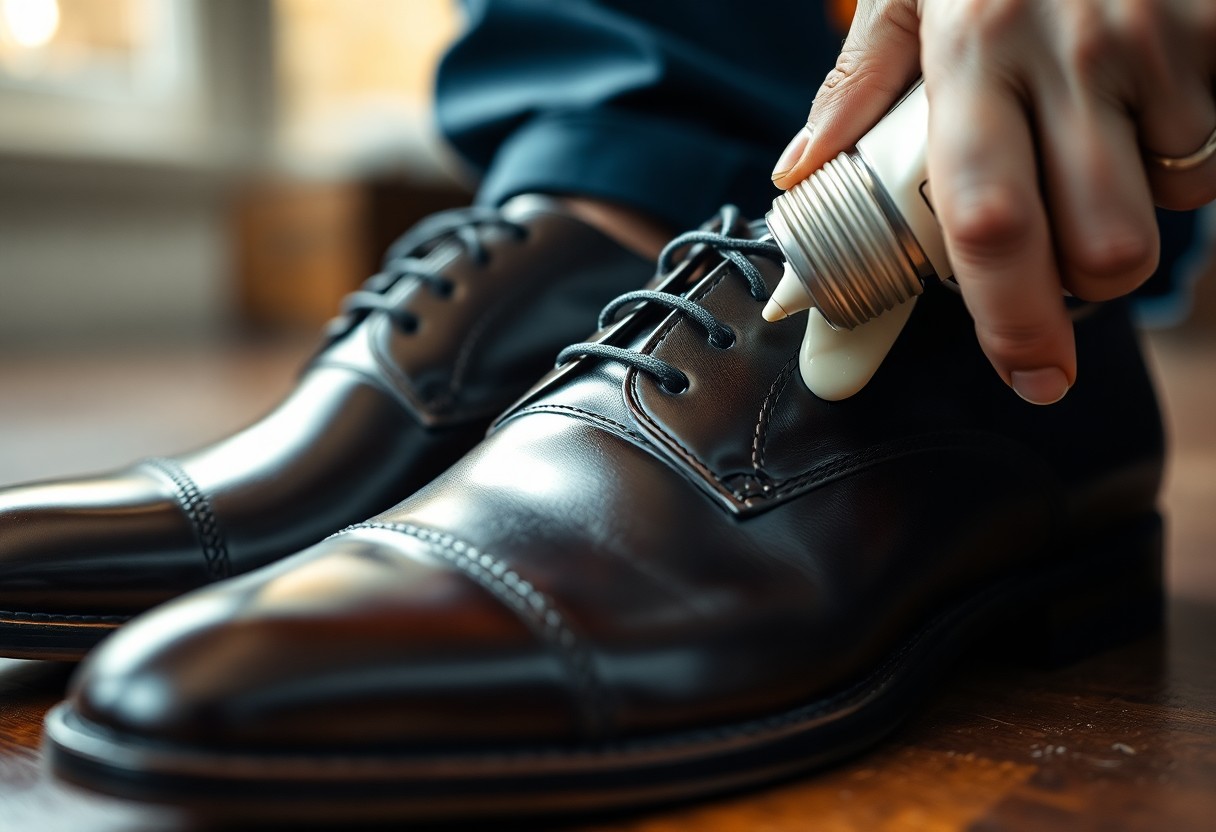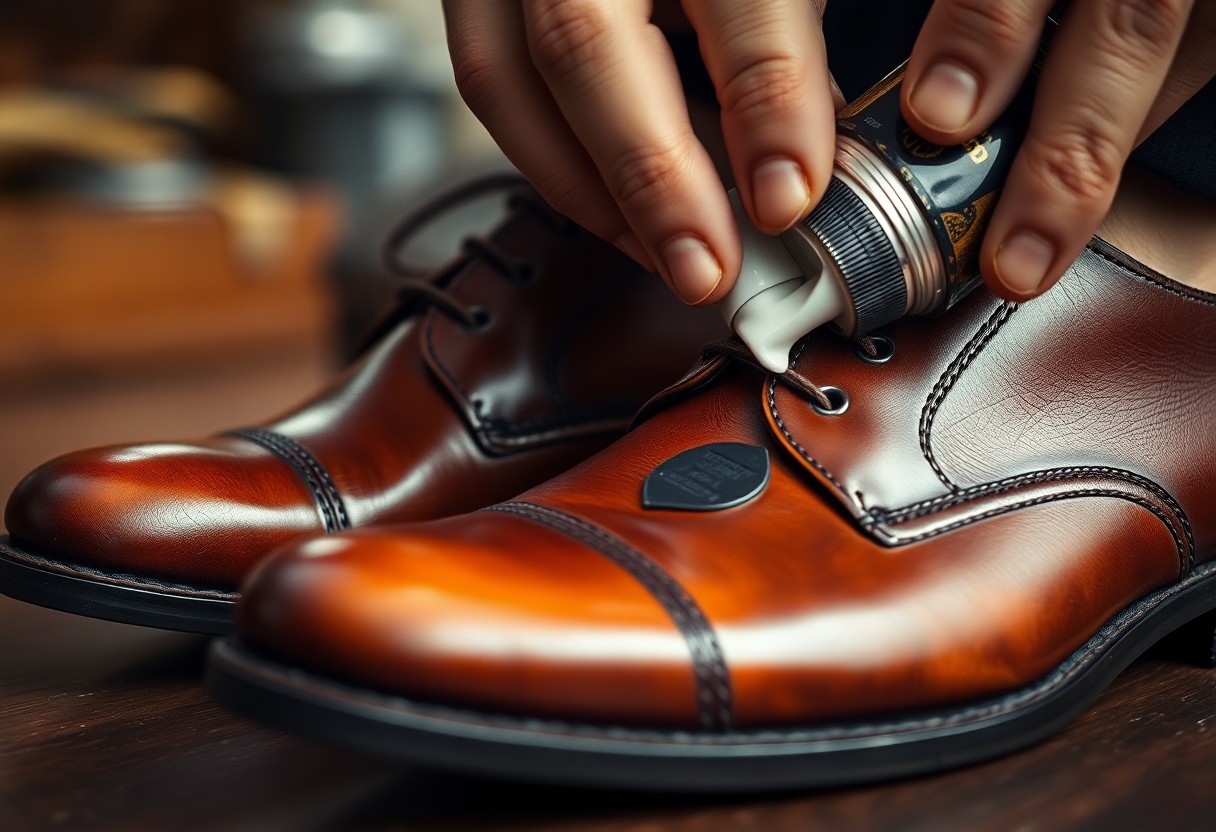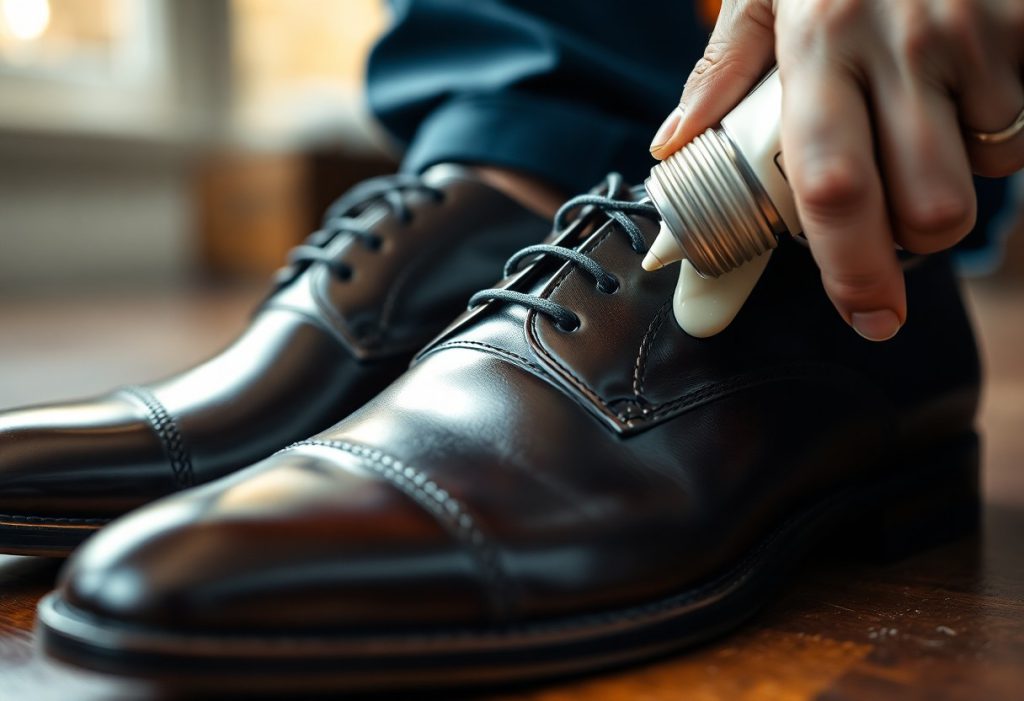Transforming your leather shoes by using darker shoe cream can significantly elevate their overall aesthetic, bringing a refined and sophisticated level to your footwear collection. By applying multiple thin layers of cream in progressively darker tones, you can achieve a look that appears expertly crafted. It is crucial to start with a cream shade that closely matches your shoe’s original color to avoid any noticeable discrepancies in coloring. For optimal results, invest in high-quality pigmented creams from reputable brands such as Saphir Medaille d’Or or Boot Black. This technique shines particularly on lighter-colored shoes, where you will notice the most remarkable transformation while preserving a natural finish.
Key Steps and Resources for Effective Shoe Color Enhancement
To successfully enhance the color of your shoes, it is essential to prepare adequately, ensuring you have the right setup and high-quality materials at your disposal. Start by establishing a clean and well-lit workspace, and allocate sufficient time to apply multiple layers of cream. Before embarking on the color enhancement procedure, your shoes must be thoroughly cleaned and completely dried. This preparation step is vital in achieving an even and enduring finish that will stand the test of time.
Essential Tools Required for Effective Shoe Cream Application
To mitigate any potential mishaps during your shoe color enhancement journey, gather the following indispensable tools: application brushes, polishing cloths, and masking tape to protect the soles. Additionally, ensure you have high-pigment shoe creams from trusted brands like Saphir Medaille d’Or or Boot Black readily available. Do not overlook the importance of cleaning supplies and a quality leather cleaner to prepare your shoes before you begin the application of the cream.
Choosing the Perfect Cream Colors for Stunning Shoe Transformations
As you embark on your color enhancement journey, it’s crucial to select shoe creams that facilitate a gradual buildup to your desired shade. Aim to begin with a cream color that closely resembles your shoe’s original tone, transitioning to darker shades as you progress. For those with light-colored shoes, this step-by-step method is essential to avoid any uneven coloring that could detract from the overall visual appeal.
The selection of tools and cream will greatly influence your final results. Your cream options should include a base color that matches the original shoe shade, along with 2-3 darker shades for layering. Using high-quality pigmented creams from esteemed brands like Saphir, Boot Black, or Collonil 1909 ensures the best possible color enhancement. For light-colored shoes, you will have the opportunity for a more dramatic darkening, while darker shoes will require more nuanced refinements.
Applying Basic Color Theory for Effective Shoe Coloring
Understanding how colors interact is essential for achieving a polished finish when darkening your shoes. Basic color theory can help you avoid common pitfalls, such as uneven application or poor shade selections. By utilizing the color wheel, you gain insights into the relationships between browns, blacks, and burgundies, which simplifies the process of predicting how various shoe creams will impact the final appearance of your leather.
Guidelines for Gradual Transition from Light to Dark Shades
One of the most critical rules in shoe coloring is the gradual progression from lighter to darker shades. Your success relies on making small, incremental adjustments. For example, a light brown shoe can transition to medium brown and subsequently to dark brown, but this process cannot be reversed. Each layer of cream should be slightly darker than the one previously applied to ensure the best possible results.
Understanding Color Depth for Superior Outcomes
Dark shoe creams feature higher concentrations of pigment, enabling them to significantly alter the appearance of your shoes. Always conduct a test on a small, inconspicuous area before applying cream to the entire shoe. Quality creams like Saphir Medaille d’Or or Boot Black provide superior color control and more consistent results, ensuring your shoes look their best.
The effectiveness of your color enhancement is heavily dependent on the techniques you employ during layering. Applying multiple thin layers yields better results than a single thick coat. Start with 2-3 layers of a lighter shade before progressing to darker tones. This method guarantees even coverage and helps avoid patchy or blotchy results that could undermine your shoes’ overall aesthetic.
Pre-Treatment Procedures for Optimal Shoe Cream Application
Before you begin applying darker shoe cream, there is a critical sequence of steps to follow. Ensure your shoes are completely dry and at room temperature to allow optimal cream absorption. This preparation phase involves removing any old polish, thoroughly cleaning the surface, and protecting areas you wish to keep uncolored. Following these initial steps will help prevent uneven coloring and lead to superior results.
Thorough Techniques for Cleaning Shoe Surfaces
To begin, it’s imperative to perform a comprehensive cleaning of your shoes. Utilize a leather cleaner to remove all dirt, old polish, and oils. Your cleaning process should be gentle yet effective, focusing on creases and seams where residue tends to accumulate. A pristine surface allows the shoe cream to penetrate evenly, promoting a flawless finish that enhances the shoe's appearance.
Effective Masking Techniques for Shoe Protection
Properly masking your shoes is essential for achieving professional results. You must protect the sole edges, welts, and any contrasting stitching using masking tape. This precaution will prevent unwanted staining and help maintain the original appearance of these elements throughout the coloring process.
Surface protection involves careful application of masking tape along the edges where the upper part of the shoe meets the sole. Ensure you cover any decorative features or light-colored stitching that you wish to preserve. Based on experiences with Midas boots and TLB Mallorca Artista shoes, adequate masking can save hours of cleanup while providing clean, professional results.
Detailed Step-by-Step Process for Darkening Shoes
To achieve exceptional results when darkening your shoes, it’s vital to follow a systematic approach. This process involves gradually building color using high-quality pigmented shoe creams. Light-colored shoes are typically easier to darken, but they also demand careful attention to prevent uneven coloring. Your success is significantly influenced by the tools you use and the application of multiple thin layers, rather than a single thick coat.
Applying the Base Layer for Effective Color Enhancement
This step marks the foundation of your color enhancement journey. Start with a shoe cream shade that closely resembles your shoe’s original color. Use an application brush to reach the edges and a polishing cloth for the main surfaces. Always protect the sole edges and stitching with masking tape to avoid any unwanted staining. Your initial layer serves as a smooth and even base for the deeper colors to follow.
Building Color Depth Through Layering Techniques
As you apply multiple layers, gradually introduce darker shades into your process. Focus on applying thin, even layers using high-pigment creams like Saphir Medaille d’Or or Boot Black. Apply 2-3 layers of each shade before transitioning to a darker tone. This method ensures your shoes develop a rich and uniform color that enhances their overall appeal.
Further enhancement hinges on proper technique and patience. Your final results are determined by how effectively you work the cream into the leather. Utilize circular motions with your cloth to guarantee even distribution. Allow each layer to dry completely before proceeding with the next application. This method can transform light brown shoes into deeper tans or enrich burgundy tones.

Perfecting the Multi-Layer Technique for Color Enhancement
Not all color enhancements have to be completed in a single session. Your success hinges on patience and gradual application. This technique involves applying multiple thin layers of shoe cream, starting with lighter shades and progressively transitioning to darker ones, ensuring an even and professional finish that enhances the overall look of your shoes.
Initiating the Process with Initial Light Layers
The multi-layer application process begins with a shade that closely matches your shoe’s original color. Avoid starting with dark cream immediately, as this can lead to spotting and uneven coloring. Apply 2-3 thin layers of light-colored cream, allowing each layer to dry for approximately 15 minutes before proceeding to the next application, ensuring a solid base for further enhancement.
Incorporating Darker Layers for Added Depth
Once your light base is established, you can gradually add darker cream layers. Opt for high-quality pigmented creams like Saphir Medaille d’Or or Boot Black for optimal results. Apply the cream using gentle circular motions to guarantee complete coverage while avoiding excess product buildup that could compromise the finish.
For the best outcomes, pay special attention to hard-to-reach areas near the sole edges. Always conduct a test on a small, hidden area first to prevent any unwanted color reactions before committing to the entire shoe. Continue layering until you achieve your desired shade, which typically requires 3-4 applications of the darker cream for a rich, deep finish.

Vital Considerations for Successful Shoe Color Enhancement
Unlike standard shoe care, enhancing color requires careful consideration of leather properties and proper product selection. It is vital to understand your shoe’s base color, leather type, and the desired outcome before embarking on the darkening process. The success of your color enhancement relies heavily on your technique and patience in applying multiple thin layers for the best results.
Recognizing Variability Among Different Leather Types
Various types of leather respond differently to color enhancement:
| Leather Type | Color Enhancement Properties |
|---|---|
| Full-grain | Best absorption, resulting in even results |
| Top-grain | Good absorption; careful application is required |
| Suede | Not recommended for cream treatment |
| Patent | Cannot effectively absorb cream |
| Corrected-grain | Limited absorption; uneven results may occur |
Addressing Common Problem Areas During Application
Common issues often arise near seams, creases, and toe areas. It is crucial to apply cream with extra caution in these areas to prevent excessive color buildup that could mar the overall appearance. Identifying potential problem spots before you begin will assist in avoiding uneven coloring and achieving a more polished finish.
At the outset of your color enhancement project, test the cream on a small, hidden area to gauge its effects and ensure compatibility. Your meticulous attention to detail in these sensitive areas will directly affect the final quality of your shoe’s appearance. Pay extra care to the welt area, where excess cream can easily accumulate, leading to uneven results.
- Apply lighter coats to creases to ensure even coverage
- Avoid heavy buildup near stitching to maintain integrity
- Use masking tape to protect the soles and prevent staining
- Work in small sections for the best results, enhancing control
Common Questions Regarding Shoe Color Enhancement
What is the best way to start darkening light-colored shoes with shoe cream?
Begin by selecting a shoe cream color that closely matches your shoe’s original shade. Apply several thin layers using high-pigment shoe cream brands such as Saphir Medaille d’Or or Boot Black. Be sure to cover sole edges and stitching with masking tape to protect these areas during the process. Add 2-3 layers of the lighter shade before transitioning to darker colors for a seamless effect.
Which tools are recommended for applying shoe cream during color enhancement?
Utilize an application brush for reaching hard-to-access areas near the sole edges, and a polishing cloth for the main surfaces to aid in distributing the cream evenly into the leather. These tools enable complete coverage and a smooth application across all shoe areas, enhancing the overall finish.
How can I ensure an even color result when darkening shoes?
To achieve an even finish, apply multiple thin layers rather than one thick layer. Start with a lighter shade and gradually progress to darker shades. Use gentle, circular motions with your cloth to work the cream into the leather effectively, allowing each layer to dry completely before applying the next. This meticulous method effectively prevents spotting and creates a uniform, smooth finish for your shoes.
The Article How to enhance shoe color using darker shoe cream tips for a polished look appeared first on My Shoes Finder
The Article Enhance Shoe Color with Darker Shoe Cream Tips for a Polished Look Was Found On https://limitsofstrategy.com


I love how you’re highlighting the transformative power of shoe cream! There’s something truly satisfying about taking a pair of shoes from a worn look to a polished finish. I’ve experimented with darkening my lighter leather shoes, and it’s fascinating to see how a simple product can elevate their entire aesthetic.
It’s great to hear your thoughts on the impact of shoe cream. There’s something quite special about the process, isn’t there? Transforming a pair of shoes can feel a bit like restoring a piece of art. When you apply that cream, you’re not just adding color; you’re reviving the leather, enhancing its character and history.
I completely relate to that satisfaction you mention. There’s something almost therapeutic about taking the time to bring a pair of shoes back to life. I’ve found that the right shoe cream can not only change the color but also enhance the texture of the leather. It’s like nourishing the material, and that can make a big difference in how they feel and look.
I’m glad you enjoyed the article! If you’re interested in exploring some great shoe cream options to enhance your collection, check out this link for some top recommendations!
https://mannland5.com/octopus
I’m glad the article resonated with you! There’s something really special about taking care of our shoes, isn’t there? The process of darkening lighter leather can feel like giving them a fresh identity. It’s fascinating how a little care can bring out the character in the leather, too.
This blog post truly captures the art and science behind shoe care and transformation. I’ve often found that the process of applying darker shoe cream doesn’t just enhance the aesthetic appeal of my leather footwear; it also feels like a meditative ritual. There’s something satisfying about layering on those thin coats and watching the color deepen, especially on previously overlooked pairs.
It’s great to hear that you resonate with the blending of art and science in shoe care. There really is something special about the ritual of applying darker shoe cream, isn’t there? It’s almost like giving new life to footwear that perhaps hasn’t seen the light of day in a while.
I’ve been experimenting with darker shoe creams lately, and I have to agree, it’s like giving your shoes a whole new personality! I started with a pair of light brown oxfords that had seen better days. Following the multiple thin layers approach really surprised me with how the color deepened without looking overly artificial.
It’s great to hear you’re enjoying the transformation that darker shoe creams can bring. There’s something really satisfying about breathing new life into a pair of shoes that might have felt a bit tired. That gradual layering method lets you have control over the outcome, too.